Studies on the Pyrazine Complexes of Some Diaryltellurium Dihalides
J. K. Narwal1, Shashi Chhabra1, R. K. Malik1, Sapana Garg1 And K.K. Verma2
1JVMGRR College, Department of Chemistary, CharkhiDadri, Haryana, India. 2Department of Chemistry, MaharshiDayanand University, Rohtak, India.
DOI : http://dx.doi.org/10.13005/ojc/290409
Article Received on :
Article Accepted on :
Article Published : 07 Dec 2013
Nine new Pyrazine Complexes of diaryltelluriumdihalides, R2TeX2.Pyz (R =p-methoxyphenyl, p-hydroxyphenyl and 3-methyl- 4-hydroxy phenyl; X=Cl, Br, I; Pyz = pyrazine) have been prepared by reactions of diaryltelluriumdihalides with pyrazine in 1:1 molar ratio. These complexes have been characterized by elemental analysis, conductance and cryoscopic measurements, infrared and proton magnetic resonance spectral studies. Conductance studies in nitrobenzene, acetone and acetonitrile predict their non-electrolyte type behaviour in these solvents, which is well supported by cryoscopic data in nitrobenzene. IR and 1H NMR studies suggest the unidentate nature of pyrazine in these complexes, involving only one nitrogen atom in coordination. Thus, tellurium in R2TeX2.Pyz complexes attains a coordination number of five probably in a square pyramidal.
KEYWORDS:Pyrazine Complexes;Diaryltellurium Dihalides;Aryltclluriumdihalides
Download this article as:| Copy the following to cite this article: Narwal J. K, Chhabra S, Malik R. K, Garg S, Verma K. K. Studies on the Pyrazine Complexes of Some Diaryltellurium Dihalides. Orient J Chem 2013;29(4) |
| Copy the following to cite this URL: Narwal J. K, Chhabra S, Malik R. K, Garg S, Verma K. K. Studies on the Pyrazine Complexes of Some Diaryltellurium Dihalides. Orient J Chem 2013;29(4). Available from: http://www.orientjchem.org/?p=1063 |
INTRODUCTION
Aryltclluriumdihalides are known to behave as Lewis acids and form molecular complexes with several nitrogen, oxygen and sulphur donor bases. It has been reported1 that Lewis acidity of tellurium atom falls significantly on going from RTeX3 to R2TeX2.Kulkarni and coworkers screened the adducts of a,a’ –bis(3-nitro/amino benzoyl) tellurium dichloride with N donor bases for biological activity and were found to be effective Ach E inhibiting agents2.
ShekharSrivastava and coworkers3 have prepared R2TeX2.L type compounds where R = benzyl and L = 2,2′-bipridyl; 1,10-phenanthroline and neocuproine. In these adducts, donor ligands are coordinated to tellurium atom. In the view of this and in continuation of our earlier work4,5 on reactions of various diorganyltelluriumdihalides R2TeX2with some N-donor bases we hereby, report the synthesis and characterization of pyrazine complexes of bis(p-hydroxyphenyl),bis(3-methyl-4-hydroxyphenyl),bis(p-methoxy phenyl) tellurium(IV) dihalides.
EXPERIMENTAL
Materials and Methods
All the chemicals used were of Analytical Reagents grade. Solvents were purified and dried by conventional methods.
Preparations
Ail the preparations have been carried out in a dry conditions under inert atmosphere of dry nitrogen, as the compounds are sensitive to moisture and air.
Preparation of Diaryltellurium(IV) Dihalides
Bis(p-hydroxyphenyl)tellurium dichloride, bis(3-methyl-4-hydroxyphenyl) tellurium dichloride and bis(p-methoxyphenyl)telIurium dichloride were obtained by reactions of tellurium tetrachloride with phenol, o-cresol and anisole respectively. The diaryltelluriumdichlorides were converted to corresponding dibromides and diiodides by halogen exchange processes by using KBr or KI in dry methanol.
Preparation of Pyrazine Complexes
Pyrazine Complexes of Bis(p-hydroxyphenyl)tellurium(IV) Dihalides
A saturated solution of pyrazine (0.40 gm, 5.0 mmol) in benzene (~10 ml) was added to a saturated solution of 5.0 mmol of R2TeX2 (1.92 g, 2.37 g, 2.84 g for chloride, bromide and iodide respectively) in about 20 ml of methanol. The contents were stirred for about 3 h which resulted in the separation of a dark coloured solid product. This was filtered, extracted with diethyl ether and dried over P4O10 in vacuum desiccator.
Pyrazine Complexes of Bis(3-methyl-4-hydroxyphenyl)tellurium(IV)Dihalides
A saturated solution of pyrazine (0.40 gm, 5.0 mmol) in benzene (~10 ml) was added to a saturated solution of 5.0 mmol of R2TeX2 (2.06 g. 2.51 g. 2.98 g for chloride, bromide and iodide, respectively) in about 20 ml of dry methanol. The contents were stirred for 4 h. Brown coloured solid product thus obtained was filtered, washed with diethyl ether and dried over P4O10 in vacuum desiccator.
Pyrazine Complexes of Bis(p-methoxyphenyl)tellurium(lV) Dihalides
A saturated solution of pyrazine (0.40 gm, 5.0 mmol) in benzene (~10 ml) was added to a saturated solution of 5.0 mmol of R2TeX2 (2.06 g. 2.51 g. 2.98 g for chloride, bromide and iodide respectively) in methanol + chloroform (20:80). The contents were stirred of 4 h. Orange brown solid product obtained was filtered, extracted with diethyl ether and dried over P4O10 in vacuum desiccators.
Physical studies
Elemental analyses for Carbon, hydrogen and nitrogen contents were got estimated from Sophisticated Analytical Instrumentation Facility, Punjab University, Chandigarh, India on a ELEMENTAR VARIO EL III or CARLO ERBA Model 1108. The conductance studies were carried out in acetone, nitrobenzene and acetonitrile on a highly sensitive Systronics Conductivity Bridge Type 305. A dip type cell with smooth platinum electrodes was used. The molecular weights of the complexes of diaryltellurium(IV) dihalides have been determined cryoscopically using purified nitrobenzene as the solvent. A Beckmann’s freezing point apparatus is used. Infrared spectra of the complexes of diaryltelluriumdihalides prepared during this course of study have been recorded in the region 4000-400 cm-1 on a SHIMAZDU FTIR-8300 or PERKIN ELMER Model 2000 FTIR Spectrometer using KBr pellet technique. The spectra were got recorded from Dr. B.R. Ambedkar Centre for Biomedical Research, University of Delhi, Kurukshetra University, Kurukshetra and Sophisticated Analytical Instrumentation Facility, Panjab University, Chandigarh. ‘H NMR spectra were recorded on a BRUKER AC-300F operating at 299.9486 MHz and BRUKER AVANCE II 400 NMR spectrometer operating at 400.13 MHz. The data were obtained from Sophisticated Analytical instrumentation facility, Punjab University, Chandigarh. The solutions were prepared in deuterated DMSO-d6. Spectra were recorded at room temperature immediately after preparing the solution using tetramethylsilane as an internal reference.
RESULTS AND DISCUSSION
These diaryltelluriumdihalides when reacted with pyrazine give 1 : 1 type complexes,
R2TeX2.L as per scheme-1
R2TeX2 + Pyz → R2TeX2.Pyz
Where
R =p-hydroxyphenyl, 3-methyl-4-hydroxyphenyl, p-methoxyphenyl
Pyz = pyrazine
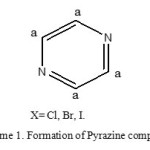 |
Scheme 1. Formation of Pyrazine complexes : Click here to View figure |
All the compounds were analysed for their tellurium and halogen contents and some for carbon, hydrogen, nitrogen contents as well(results are given in table l).These complexes of diaryltellurium(IV) dihalides are generally coloured, crystalline solid which are fairly stable in dry air. These are generally soluble in polar organic solvents and insoluble in non polar solvents.
* melts with decomposition
Pyz = pyrazine
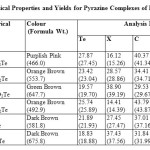 |
Table I. Analytical Data, Physical Properties and Yields for Pyrazine Complexes of Diaryltellurium(IV) Dihalides. Click here to View table |
CONDUCTANCE MEASUREMENTS
The molar conductance data for pyrazine complexes of R2TeX2. Pyz are reported in Table II.
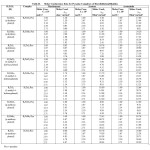 |
Table II. Molar Conductance Data for Pyrazine Complexes of DiaryltelluriumDihalides Click here to View table |
Lmreported2 for 1 : 1 electrolyte : nitrobenzene = 20 – 30, acetone = 100 – 140 and acetonitrile = 120 – 160.
The LMvalues for the pyrazine complexes in nitrobenzene, acetone and acetonitrile are generally much lower than those reported for 1 : 1 electrolytes thus suggesting their non-electrolyte type behaviour in these solvents. Also the LMvalues in a particular solvent for pyrazine adducts varies in the order.
R2TeI2.Pyz > R2TeBr2.Pyz > R2TeCl2.Pyz
CRYOSCOPIC MEASUREMENTS
The cryoscopic data for the pyrazine complexes (Table III) show that molecular weights of these complexes arc quite close to the formula weights, thus suggesting their molecular monomeric nature in nitrobenzene, as predicted by conductance studies as well.
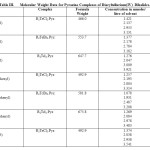 |
Table III. Molecular Weight Data for Pyrazine Complexes of Diaryltellurium(IV) Dihalidcs. Click here to View table |
IR Spectra
The important IR data (cm-1) for pyrazine complexes of diaryltelluriumdihalides are presented in Tables IV and V. The spectra are quite complex and the frequencies from which concrete conclusion can be drawn are listed in the Tables.
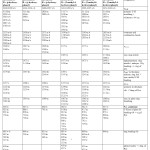 |
Table IV. IR Data (cm-1) for Pyrazine Complexes of DiaryltelluriumDihalides |
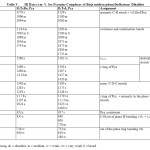 |
Table V. IR Data (cm-1) for Pyrazine Complexes of Bis(p-methoxyphenyl)tellurium Dihalides |
This may be mentioned that assignments made in the table are based on comparison of spectra of parent R2TeX2and pyrazine. The ring vibrations of these may be mixed with each other.
The pyrazine molecule (C4H4N2)has the centrosymmetric and planar structure with D2h symmetry in the vapour and solid phases. The assignments of the infrared spectra of pyrazine in solid6, liquid7-8 and vapour9-10 phases and in solution6,10,11 have been reported to be in accord with the D2h symmetry. The important infrared frequencies which are observed10,11 in free pyrazine are 3061, 3011 (nCH), 1483, 1412 (nring), 1150 (nring), 1130 (dch)9 1061 (dch), 1019 (dring), 785(ucm)and 418(nring). In metal complexes in which both N-atoms of pyrazine are coordinated to two metal atoms, the D2h symmetry is preserved but is removed in unidentate coordination. Several modes of pyrazinein complexes have upward shift in wave number in comparison with those of free pyrazine. This blue shift in pyrazine bands in the complexes indicates the coordination through N-atom as in pyridine12,13. This
blue shift in ppyrazine stretching may be due to back bonding from tellurium to pyrazine ring through formation of extensive p-bonding.
Lever et al14-17and Kantara18 have reported that in complexes where pyrazine is bonded through only one N-atom, the low local symmetry experienced by the pyrazine moiety atoms allows a band to appear in the 950-1000 cm-1 region, which may be taken as an evidence for unidentate nature of pyrazine. This band is reported to be absent in the bridged polymers where pyrazine functions as bidentate ligand. In pyrazine complexes of diaryltellurium(IV) dihalides prepared during this course of study exhibit a medium to strong intensity band in this region, thereby confirming the unidentate nature of pyrazine in these complexes. Thus, tellurium in R2TeX2.Pyz complexes attains a coordination number of five probably in a square pyramidal environment.
1HNMR Spectra
The 1H NMR data for pyrazine complexes are given in Table VI. The four equivalent protons of free pyrazine which resonate at 8.5919d ppm appear at slightly downfield side in R2TeCl2.Pyz complexes due to shifting of electron density from N of pyrazine to Te of R2TeCl2. Also in some cases separation between the pyrazine protons has been observed which may be due to monodentate nature of pyrazine. Conversely, the aryl protons of R2TeCl2group resonate at upfield side as compared to the parent diaryltellurium dichloride, indicating thereby the shielding of phenyl protons especially those orthoto TeCl2 group. This may be due to an increase in electron density at the tellurium atom after accepting the electrons from the pyrazine molecule. Similar shift has also been reported for pyridine complexes19, 21,22 of RTeCl3. Thus tellurium in these pyrazine complexes acquires a coordination number of five.
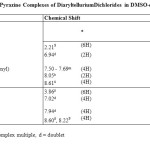 |
Table VI. 1H INMR Data (d ppm) for Pyrazine Complexes of DiaryltelluriumDichlorides in DMSO-d6. |
CONCLUSION
Bis (p-hydroxyphenyl), bis (3-methyl-4-hydroxyphenyl) and bis(p-methoxyphenyl) tellurium (IV) dichlorides are obtained by direct reaction of tellurium tetrachloride with phenol, o-cresol and anisole respectively.
These diaryltelluriumdihalides have been reacted with pyrazine. The solution behaviour of complexes of diaryl tellurium (IV) dihalides has been investigated by conductance measurement in nitrobenzene, acetone and acetonitrile and cryoscopic measurement in nitrobenzene. The Structural aspects of the complexes of diaryltelluriumdihalides have been investigated conjointly by infrared and proton magneticresonance spectroscopy. These complexes of diaryl tellurium (IV) dihalides are generally coloured, crystalline solid which are fairly stable in air. These are generally soluble in polar organic solvents and insoluble in non polar solvents.
ACKNOWLEDGEMENTS
The authors are thankful to Maharshi Dayanand University, Rohtak for providing the necessary facilities.
REFERENCES
- G. Maslakov, E. Gresham, T. A. Hamor, W. R. Mcwhinnie, M. C. Perry and N. Saikh, J. Organometal. Chem., 480,261 (1994).
- Y. D. KulkarniArchana Rani and R. A. Siddiqui, J. Indian Chem. Soc, 69, 353 (1992).
- ShekharSrivastava, Dilip Kumar Soni and Hari Shankar Gupta, J. Indian Chem. Soc. ,73, 255 (1996).
- K. K. Verma and Sunil Verma, Proc. Indian Council of Chemist 27th Annual Conference, GurukulKangri University, Haridwar, Dec. 26-28, 2008, paper no. IO-10, p. 23.
- K. K. Verma and Sunil Verma, Proc. Indian Council of Chemist 27th Annual Conference, GurukulKangri University, Haridwar, Dec. 26-28, 2008, paper no. IO-17, p. 27.
- G. Sbrana, V. S. Chettino and R. Righini, I Chem. Phys., 59, 2441 (1973).
- R. C. Loard, A. J. Marson and F. A. Miller, Spectrochim., Acta, 9, 113 (1957).
- J. Zarembowitch and L. Bokibza-Sebagh, Spectrochim. Acta, A32, 605 (1976).
- S. Califano. G. Adembri and G. Sbrana, Spectrochim. Acta, 20, 385 (1964).
- J. F. Arenas, J. J. Lopez-Navarrate, J. C. Otero, J. I. Macros and A. Cardenate, J. Chem. Soc. Faraday Trans., 81. 405 (1985).
- Z. Kantarci, B. Davarcioglu and C. Bayrak, J. of Inc. Phenom. and Macr. Chem., 39, 115-121 (2001).
- N. N. Greenwood and K. Wade, J. Chem. Soc, A, 1130 (1960).
- J. K. Wilmhurst and H. J. Bernsteim, Can. J. Chem., 35, 1183 (1957).
- B. P. Lever, J. Lewis and R. S. Nyholm, Nature Lond., 189, 58 (1961).
- B. P. Lever, J. Lewis and R. S. Nyholm, J. Chem. Soc, 1235 (1962).
- B. P. Lever, J. Lewis and R. S. Nyholm, J. Chem. Soc, 3156 (1963).
- B. P. Lever, J. Lewis and R. S. Nyholm, J. Chem. Soc, 5042 (1963).
- H. D. Stidham and J. A. Chandler, J. Inorg. Nucl. Chem., 27, 397-403 (1964).
- K. K. Verma, Reena and DayaSoni, Synth. React. Inorg. Met. -Org. Chem., 29, 1033 (1999).
- Reena, Ph.D. Thesis, M. D. University, Rohtak (1998).
- Om Prakash, S. A. Iqbal and G. Jacob., Orient. J. Chem., 29(3), 1079-1084, 2013
- Neeti Rathore and Bal Krishan., Orient. J. Chem., 29(3), 1001-1008, 2013
Scheme 1. Formation of Pyrazine complexes

This work is licensed under a Creative Commons Attribution 4.0 International License.









